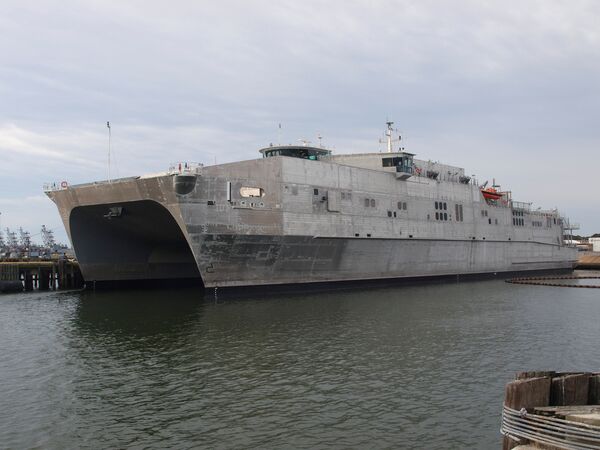
The US Marine Corps plans to use Expeditionary Fast Transport (T-EPF) vessels as bridge platforms while the Light Amphibious Warship programme is developed. (Michael Fabey)
While the US Marine Corps (USMC) and the US Navy (USN) hammer out requirements and the development of the Landing Ship Medium (LSM) or Light Amphibious Warship (LAW), the USMC will use other platforms to provide a bridge for those operations. This was stated by the service's Force Design 2030 Annual Update May 2022 released to coincide with the Modern Day Marine conference that starts on 10 May in Washington.
“In addition to the L-Class ships that are the key to our ability to provide forward-deployed MEUs (Marine Expeditionary Units) and to extend influence and combat power ashore, we also require the Medium, Landing Ship,” General David Berger, USMC commandant, writes in the update.
“The LAW programme will provide LSM manoeuvre and mobility for stand-in forces campaigning and contributions to integrated deterrence,” the update says. “In aggregate, naval expeditionary force (NEF) formations contribute to a partnered maritime defence in depth and facilitate an integrated kill-chain in conflict. While we await the delivery of LSM, which post-dates the planned operational readiness of our MLRs (marine littoral regiments), we will explore a family of systems bridging plan – including Expeditionary Transfer Dock (ESD), Expeditionary Fast Transport (T-EPF), Landing Craft Utility (LCU), and leased hulls – that can provide a basic level of mobility.”
Gen Berger adds, “Although not optimal, such vessels will provide both operational capability and a sound basis for live experimentation and refining detailed requirements for the LAW programme.”
USMC and USN officials are debating some of those topline requirements.
Looking to read the full article?
Gain unlimited access to Janes news and more...
